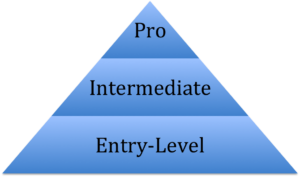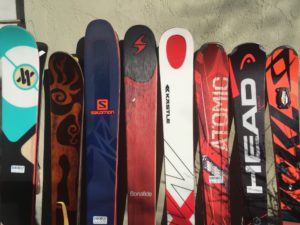When I was cutting my teeth in the ski trade in the late ‘70’s, the market was built like a classic pyramid: the broad base was composed of a large population of entry-level skis, sold mostly in packages; the next level of intermediate/advanced products didn’t add up to as many units but remained a relatively large percentage of the total; capped by a small contingent of mostly race models for experts, instructors and actual racers.
The product pyramid circa 1978.
Over the next 40 years, the ski world shifted so dramatically off-axis that today the product pyramid is completely upside down. The entry-level market still exists, but it’s thinly populated. The intermediate segment remains important but the range of choices is usually limited to a few iterations of Frontside models. In today’s market, it’s the expert – meaning anyone with the chutzpah to self-classify as same – who can over-indulge on a smorgasbord of options.
The product pyramid today.
What seismic events transpired to completely invert the product mix in the ski market? To end up in today’s condition, the entry-level market must have shriveled and the pool of experts expanded exponentially. Let’s take a peek at each segment to divine the forces that stood the ski market on its head.
Two developments doomed selection at the first price point: widespread availability and promotion of rentals as a better option for the uncommitted neophyte, and the demise of the general sporting goods chains that provided the primary outlet for so-called package skis. When I was North American product manager for Salomon in the mid-‘80’s, our largest accounts were chain stores like Herman’s, Gart Brothers (later reincarnated as Sports Authority) and Sunset Sports, none of which exist today.
The market for step-up models – meant for the vast, diverse population of intermediates – also saw it’s principal pipeline to the public shrink drastically with the demise of regional specialty chains like Ski Market in the northeast and more recently, Sport Chalet in California. There will always be a need for stepping-stone skis that coddle the less skilled and cost a bit less than models made for the more advanced; nonetheless, as the mid-market dealer base has shrunk, the center of the product range has likewise retracted.
Meanwhile, somewhere between adopting both shaped skis and fat skis as here-to-stay phenomena and the present day, manufacturers realized that they could identify, and successfully market to, all sorts of experts: freeride, freestyle, all-mountain, carver, cruiser, backcountry, skier-cross, pipe-and-park, and, of course, racers.
Looking at just the categories of alpine skis covered by the Realskiers.com test panel, there are six genres headlined by expert skis, beginning with hourglass-shaped Technical models (67mm-74mm) and ending with double-rockered Powder skis (>113mm).
Presumably, the polyvalent skier who partakes of all terrain and all conditions could rationalize owning a pair of skis in every genre. And we haven’t factored in the options offered for backcountry skiing or pipe-and-park riding.
You don’t need to have a ski (or two) in every category, but it doesn’t hurt.
That’s a lot of choice for an expert skier who in all probability wants to ski as much of the mountain as possible with but one pair of skis. It also suggests that the field of expert skiers is considerably larger than previously imagined.
The expansion of the expert ranks is partly attributable to generous self-assessment at the point of sale, as many prospective buyers fail to adequately distinguish between the skill set required to arduously descend a double-black trail and the talent that makes the same line look effortless.
Manufacturers hit on the perfect solution for taking the teeth out of expert-caliber skis without diminishing their allure: rocker, and lots of it. Just about every ski made today has some degree of rocker in the tip and tail rocker is prevalent among skis 95mm or wider at the waist.
Lest you think, Dear Reader, that I raise this subject in an accusatory or scolding tone, be reassured that I find this stratagem brilliant. Faced with declining sales, suppliers found a way to raise their average selling price by dramatically richening their mix. In the process, they’ve made some astoundingly good sticks.
Our on-snow results validate the diversity of this multi-faceted expert market, as each genre has a clearly definable behavioral bundle. The eternal quest to win the favor of the skiing public has resulted in an almost overwhelming abundance of choice for advanced to expert skiers no matter where or how they like to slide.



